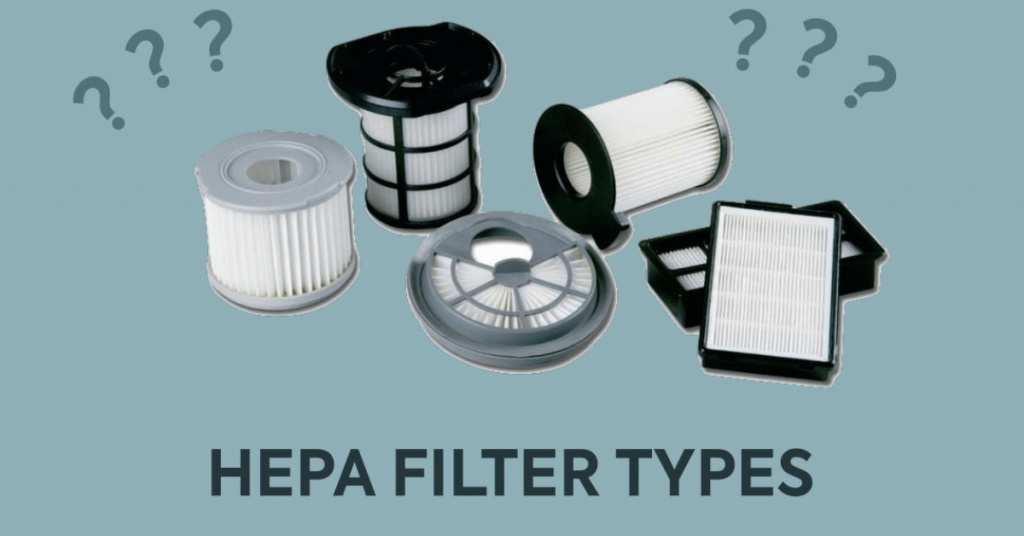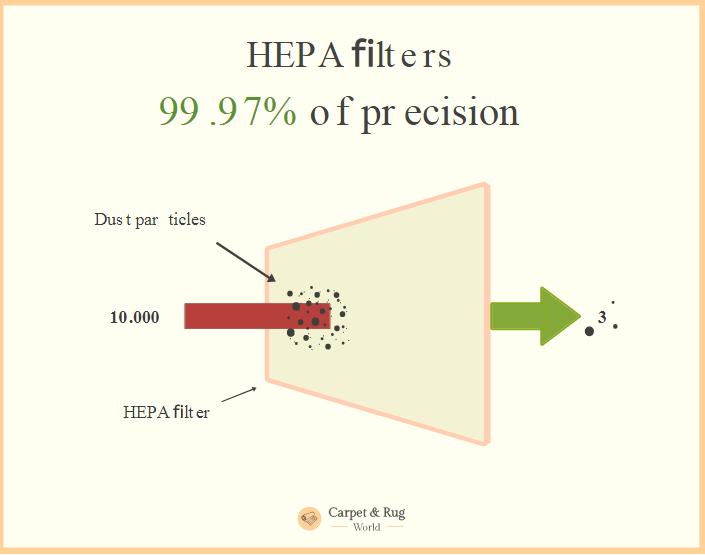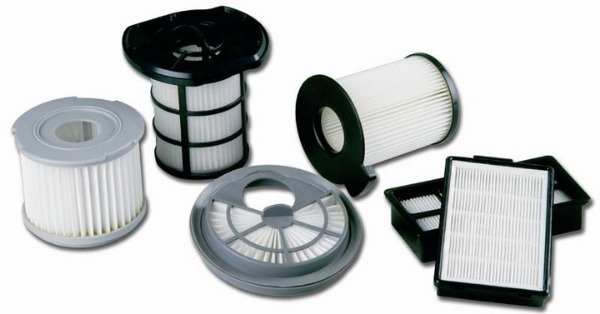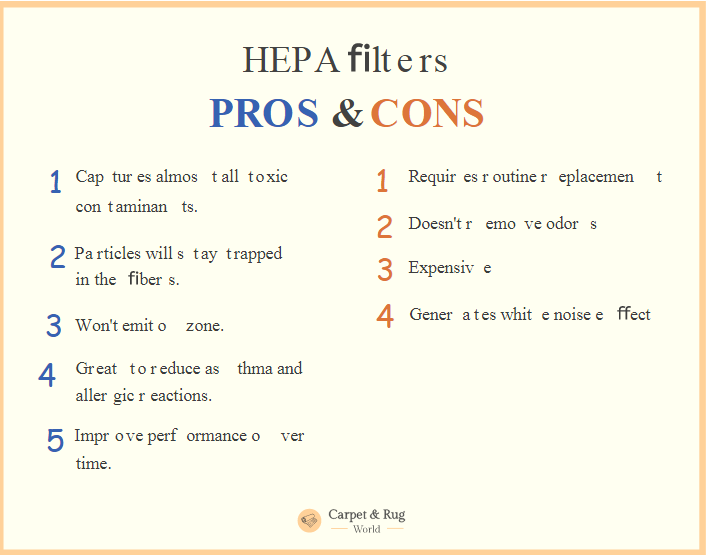You may have been looking at HEPA vacuums, air conditioners or air purifiers because you’ve seen they’re better than regular ones when it comes to how they filter the dust and dirt…
And it’s true! They are said to be the best when cleaning or purifying the air inside a home.
But now that you’re willing to buy a HEPA air purifier or vacuum, you may get a bit confused due to all the different HEPA denominations… “true-HEPA”, “HEPA-type”, “99%-HEPA”, “HEPA-like”, and so on.

Well, they’re not the same and quality varies from one to another.
So, be careful when buying a “HEPA filter type”, as you could be paying a lot of money for something that really isn’t what it says it is…
This article will try to explain everything you need to know to avoid scams!
What is a HEPA Filter?
First, you need to know what a HEPA filter is and how it works to understand later on how they are classified.
HEPA stands for high-efficiency particulate air and a HEPA filter is a high-efficiency particulate absorbing filter. That means they are capable of absorbing more and smaller particles than regular filters. Therefore, they do a better job at cleaning the air or whatever you’re using it for.
In the end, HEPA is just a standard that measures the level of efficiency of a filter to absorb and trap particles. And for a filter to be classified as HEPA, it needs to satisfy certain levels of efficiency.

HEPA filters must, at least, trap 99.97% (in the US) and 99.95% (in the European Union) of the particles, these being as small as 0.3 micrometers.
For you to understand, this type of particles are called microns and they have different sizes. And depending on the capacity of the vacuum you have, you’ll be able to remove them or not.
Here you have some of the particles you may have at home and their sizes:
– Pure oxygen: 0.0005 microns
– Bacteria: 0.3 to 60 microns
– Dust mites: 1 to 10 microns
– Car emissions: 1 to 150 microns
– Mold: 3 to 12 microns
– Spores: 3 to 40 microns
Later on, when looking at the general classifications, you’ll see and understand more about these percentages and how they’re classified.
You can find HEPA filters on air purifiers, HVAC systems, vacuums and cars.
What are HEPA Filters made of?
HEPA filters can be made of vegetal and synthetic fibers, animal hair, coarse glass, synthetic foams, etc.
The materials from which they’re made are tangled all together to form a compressed paper-like sheet. And these sheets are usually pleated to increase the surface area.
Now let’s see how they work.
How do Hepa Filters Work?
All HEPA filters work the same, but they don’t perform the same.
Let’s see how this goes…

HEPA filters work the following way: as the filter fibers are compressed so tightly, when the air flows through them, it is very difficult for the small particles to get through without getting stuck to them.
This way almost all the air contaminants are trapped in the fiber sheets. And these can happen in 4 main ways:
– Direct impaction: large particles collide with the fibers and get stuck to it.
– Sieving: large particles get stuck between two fibers.
– Interception and diffusion: thanks to the airflow, medium and small particles move around the fibers and eventually get stuck in the fibers.
The purpose behind these is to clean the air we breathe as much as possible.
HEPA filters can also be used with pre-filters (usually made from carbon) to extend their useful life, as they are very expensive. And if used alone they can last a lot less.
What these pre-filter do is the do the first filtration process to remove the bigger particles to avoid clogging the HEPA filter later on. This way, the HEPA filter only has to remove the smaller particles that escape from the pre-filter.
Types of HEPA Filters

Now, when choosing a HEPA filter, it can be a bit tricky to choose the right one and avoid scams.
Brands will use clever marketing techniques to make you think you’re buying something as good and effective as HEPA filters but a bit cheaper. And lots of people buy it!
Don’t make the same mistake as them.
There are different types of HEPA filters based on their level of efficiency and that’s what we are going to look at right now.
General Classification: MERV
HEPA filters are measured based on the size of the particles the can absorb.
And the general classification used in the US is called MERV (Minimum Efficiency Rating Value), which goes from 1 (least efficient) to 18 (most efficient) in a scale range. And his rating system must appear on the packaging.
– MERV 1-4 filters won’t do much. Just remove hair and big dust particles. They have the lowest price at the store. They have an efficiency below 20%.
– MERV 5-8 filters have an efficiency between 20% and 35%.
– MERV 9-12 filters are what you’ll find for residential appliances. Their efficiency is between 40% and 75%.
– MERV 13-18 filters are typically used for bigger buildings such as hospitals. And MERV 18 is the highest rating, also known as ULPA (Ultra Low Particulate Air). But can also be found for commercial/residential use.
Now, the European Union standards are the following (in case you see it written in this format):

Marketing Classification
Brands have used marketing as a way to differentiate from other competitors in the sector.
There are many classifications but here are the main types of HEPA filters that you’ll find in the market:
ULPA filters
ULPA means Ultra Low Particulate Air and it has the highest MERV rating, that is MERV 18. It will remove the smallest particles.
Due to its high efficiency, it can be pretty expensive (around $1.000), so there are only a few appliances with this type of filter.
The secret behind its efficiency is how tight the fibers in the filter are and also because they have a larger surface area.
True HEPA filters
True HEPA filters are classified with a MERV 17, which is also very high.
If what you need is something to remove mold spores, pet dander, dust mites, fine dust and pollen, then this is your best option.
It will work miracles reducing the number of allergens you have at home.
Some examples are:
[amazon link=”B002VXDCHW” title=”IQAir Medical-Grade Air (HyperHEPA Filter)”/]
[amazon link=”B004VGIGVY” title=”Germ Guardian True HEPA Filter Air Purifier”/]
[amazon fields=”B002VXDCHW” value=”thumb”]
[amazon fields=”B004VGIGVY” value=”thumb”]
[amazon fields=”B002VXDCHW” value=”button”]
[amazon fields=”B004VGIGVY” value=”button”]
HEPA filters
Some manufacturers say there are some differences between HEPA and True HEPA filters. But no.
Their actually the same. They just put True to ensure you they meet the actual HEPA standards (MERV).
HEPA-like/type/style/99%
If you find a filter classified as “like, type or style” run away. They will most likely not satisfy nor meet the HEPA standards and you’ll be wasting your money.
They will have the same or similar design but will have a lower efficiency. So in terms of efficiency, they’re just like regular vacuums or regular air purifiers.
Other non-HEPA Filters
HEPA filters aren’t the only option. There are other types of filters, with the same or even better efficiency.
Here are some of them:
– [amazon link=”B07D5S5C7V” title=”Ion Filters”/]. They work quite differently as they use charged ions to bond with unwanted particles that are floating in the air. This way they become heavier and they drop into the ground. This process prevents us from breathing them. The only downside is that the particles aren’t removed and so they can go back up in the air and get all cluttered in the same area, creating black spots.
– [amazon link=”B01JQVKNMI” title=”EPA Filters”/]. The downside to this type of filters is that they capture between 85% and 99.5% of all particles, and that’s a huge variety range. In the end, they’ll end up being less efficient than HEPA filters.
– [amazon link=”B000V9FWTY” title=”Microfiltration”/]. They have similar results to HEPA filters, but different process. It uses multiple layers of filters. The first one is cellulose and captures large particles. The second one is polypropylene and captures smaller particles. This process will capture between 90% and 98% of the particles.
– [amazon link=”B07FXNQ6PS” title=”Carbon Filters”/]. They do different things. They are used to capture odors, such as smoke and chemicals from the air.
– [amazon link=”B01JQVKNMI” title=”Electrostatic Filters”/]. They charge particles into the air and afterwards filters and collects them on a place that needs to be removed and washed regularly.
These are the most commonly know filters you can find in the market.
HEPA Filter Pros and Cons
These are the main pros and cons:

Conclusion
We’ve covered everything you need to know about HEPA filters on this post.
If you really want to improve the air quality of your home, a HEPA filter is just what you’re looking for. If you’re going to buy one, prepare yourself, cause they can be pretty expensive.
But believe me, HEPA filters are worth the money.
